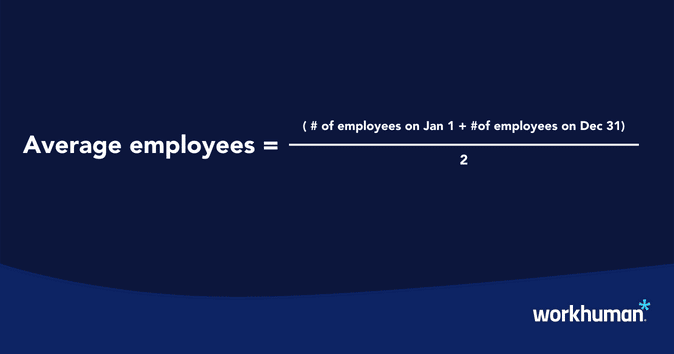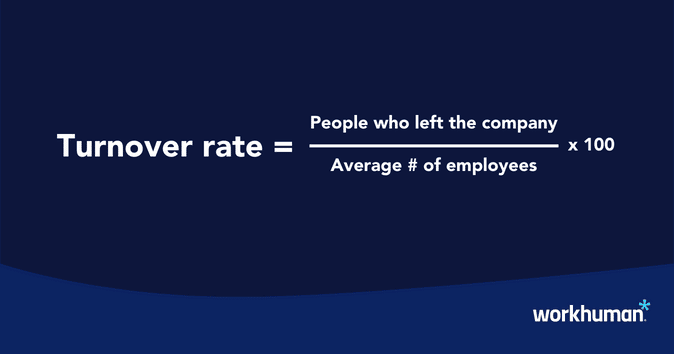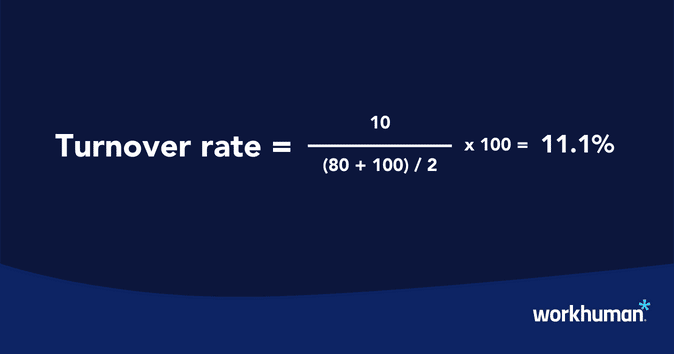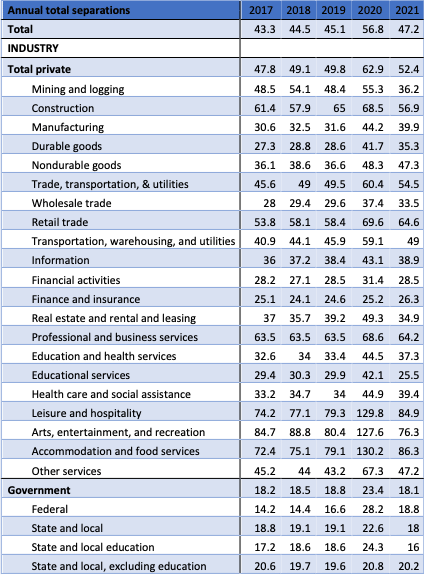How to Calculate Employee Turnover Rate and Why It's Important

“Turnover” is a scary word in the workplace. But employee turnover is a natural phenomenon in every company. No one stays at one company for their entire career. In fact, the Bureau of Labor StatisticsOpens in a new tab estimates average employee tenure is about four years and has been since 2018.
Employee turnover rate is also not inherently negative. People leave companies for a number of reasons, some of which are outside of the company’s control. Employee turnover also opens up the opportunity to bring in new viewpoints that can help the company innovate.
While turnover is a natural byproduct of running a business, you don’t want a revolving front door. Because that can get expensive.
A Gallup poll estimated the cost of replacing an individual employee was up to 2x their annual salary. The total cost of voluntary employee turnover to US businesses: one trillion dollars.
All of that helps underscore why it’s important to understand your company’s employee turnover rate. Not only can the actual number help quickly gauge if your turnover rate is something to be concerned about, the actual process of calculating employee turnover rates can provide key context you can use to discern if the employee turnover at your company is the nature of business or a problem.
What is employee turnover rate?
Employee turnover rate is a calculation of the percentage of employees who leave your company over a certain time period, either voluntarily or involuntarily.

Voluntary turnover vs. involuntary turnover
Involuntary separations largely consist of employee dismissals, either on an employee basis or through company restructures. Voluntary separations can be broken down into two camps: pull reasons and push reasons.
Pull reasons
These are reasons outside of your company’s control. An employee might be returning to school, taking care of a family member, or moving to a place where a commute isn’t possible and remote work isn’t feasible.
It’s a life-dictating circumstance. One that shouldn’t be perceived as a “bad thing.” It's a natural way to bring in new talent and perspectives to keep pushing the company and other employees forward.
Push reasons
These are very much within your company’s control. Push reasons include dissatisfaction with working conditions, job responsibilities – even the overall company culture.
A high turnover rate due to pull reasons? That could very likely be an outlier. The randomness of life. A high turnover rate due to push reasons? That demands your attention.
What is a good turnover rate?
This is a tough question to answer with a clean number. A Bureau of Labor Statistics (BLS) report put the overall 2021 turnover rate at about 47%.
Just because a turnover rate exceeds that average does not necessarily mean trouble’s brewing. Depending on the specific occupation or industry, turnover rate could be above the national average. For example, in 2021, the turnover rates in the construction, leisure and hospitality, and retail industries were all at least 10 percentage points above the average, with hospitality leading the way at 85%. Measuring employee turnover rate is important to establish a baseline and give you the complete context.
It’s important to keep in mind that zeroing out turnover isn’t the goal here. An extremely low level of employee turnover could leave the business stagnant.
What is a high turnover rate?
Again, this will depend on your business, the occupations of the workers, and a host of other factors. A high employee turnover rate is one that is consistently outside your company average and is causing disruptions across your business.
The average turnover rate is an average for a reason. Sometimes the turnover rate is above or below, but that is again why the context of your turnover rate matters. And thus why calculating said turnover rate is so important.
How do you calculate employee turnover rate?
Now for finally calculating your company’s employee turnover rate. You’ll need two numbers: the average number of employees your company had over the time you’re measuring and how many employees left during that same time.
Turnover calculation
For the average number of employees for a calendar year you’ll use the following employee turnover formula:

To calculate the turnover rate itself:

So let’s say on January 1 your company had 80 employees and on December 31 it had 100. And over the course of the year 10 people left the company.

Your turnover rate is 11.1%. Pretty good! Now let’s add some context.
It often isn’t enough to calculate one turnover rate for the entire company. Employee turnover rates fluctuate with variables such as industry, region, and the occupations in your company.
You might also want to include the duration of employment. If you have a disproportionate number of employees leaving within 18 months consistently, that’s something you want to know but may not be reflected in the turnover rate formula.
And though we used annual turnover in the example for simplicity’s sake, more frequent measurements can provide even more context around the total number. For example, monthly employee turnover rate can help you find patterns during the year like spikes during a busy quarter or after an annual bonus.
Employee turnover rate by industry

Source: U.S. Bureau of Labor Statistics
As mentioned already, an important factor in understanding the employee turnover rate at your company is comparing it with the industry you’re in. As seen from BLS data on annual average job opening ratesOpens in a new tab, the retail and hospitality industry consistently finds itself well above the national average employee turnover rate.
If you were to compare those employee turnover rates to those of educational services which have averaged about 32% over the last five years, they would seem astronomical rather than right in line with industry averages and thus a healthy turnover rate.
Why is measuring turnover important?
Measuring employee turnover rate is important because it can be a very costly expense for your business. Almost one-half an employee’s annual salary… Per employee. And that’s merely to backfill that employee’s role. Harder expenses to calculate include the disruption frequent turnover can have on that employee’s team and the broader company as well as their relationships with clients.
Analyze your turnover rate
Who are the employees who leave?
Calculating employee turnover rate is not just about getting a number, but also to see where there may be shortcomings in the employee experience. Are they high performers? New employees? Women? Employees of color? You can’t begin to put solutions in place until you know the depth of the problem.
When do they leave?
It’s also important to find patterns for when employee turnover is happening. Are people burning out after a year? Are there a bulk of people leaving after annual bonuses are doled out or just as you’re preparing for a particularly hectic time of year?
If yes to any of the above, it’s worth looking at what your company is doing to boost employee retention. Frequently recognizing people for their efforts can boost their well-being and take the onus of the annual bonus that often comes as a too-little-too-late way of showing employees you value them.
Why are they leaving?
As mentioned above, you may know the reasons for involuntary turnover, but understanding the reasons for voluntary turnover are important to know too. They can help you assess if an employee is leaving because the organization came up short.
Maybe there wasn’t a path for growth and they jumped at another job opportunity. Maybe they didn’t have a good experience or strong relationships with those they worked with. Worse, maybe they are seeing other employees leave so often, they’ve lost their connections to the company.

How do you reduce employee turnover?
There is no single tactic to deploy that will reduce employee turnover overnight. Reducing turnover rate requires an ongoing strategy that should touch every facet of your business.
By prioritizing the mental health and well-being of your employees through recognition and by establishing a psychologically safe, diverse, equitable, and inclusive work environment, you increase the chances of employee retention and low employee turnover.
By addressing impact areas of retention, you’ll find that you’re not “reducing turnover rates” so much as you’re ensuring your employees are engaged and valued. And, ultimately, that’s the real goal.
Frequently asked questions
Is high turnover a red flag?
Not necessarily. Context matters when assessing your company’s turnover rate. It could be mere coincidence that a number of employees are pursuing other opportunities or need to take a leave of absence. If, however, employees are leaving to work for competitors, that’s a sign of trouble.
Why is it important to measure employee turnover?
By measuring employee turnover, especially over time, you’re able to gauge your company’s ability to keep employees happy and engaged.
You should calculate employee turnover rate at least on a monthly and annual basis so that over time you can find patterns in staff turnover. Remember, a healthy turnover rate depends on a number of variables from the type of industry or occupation to the reason why employees leave.
How does turnover rate impact revenue?
Turnover rate can impact revenue positively and negatively. If, for instance, the turnover rate of your sales team is high, that can throw relationships with prospects in jeopardy and reduce the amount of business coming in.
If it’s low, and therefore employee retention rate is high, more established, trusting relationships are built which allow for a greater chance at positive business outcomes.
About the author
Mike Lovett
Mike is a senior content marketing specialist at Workhuman where he writes about the next era of the workplace. Outside the workplace, he’s an avid gardener, a frequent biker, a steadily improving chef, and a fantasy sports fanatic.